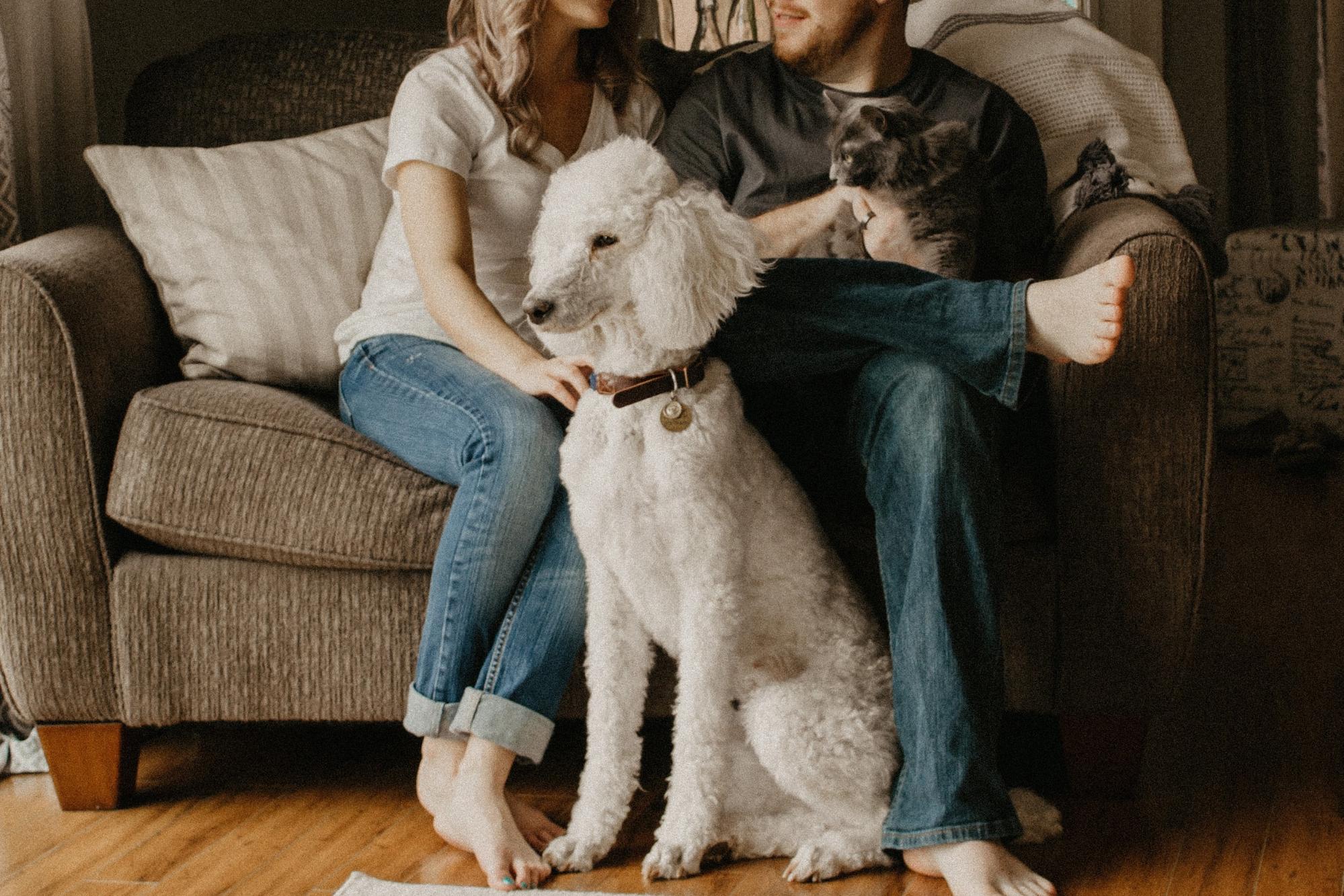
Ever heard the saying ‘you can’t teach an old dog new tricks?’ Don’t let that old wives’ tale deter you. Sometimes it can feel impossible changing a routine – especially a pet’s routine – when you’ve been doing it one way for a while. Sometimes occasional slip-ups – like not taking your dog out for its daily walk – can turn into the new norm. Over time, you and your pet get used to this unhealthy lifestyle – but things can certainly change and for the better.
The truth is, even senior pets can learn and form new habits – and if they’re on the unhealthy side (perhaps they’ve rounded out slightly), these new habits could be just the thing to save, or extend, their lives. Even if you have a healthy dog or cat (or anything in between), incorporating healthy habits can benefit them physically and mentally. Whether your pet is nine months, or nine years old, here are 10 healthy pet habits you can start implementing today to keep your pet happy and healthy!
1. Bring Your Pet in for a Checkup
Before you and your pet embark on your newfound health journey, get a quick check-up to get the green light from a qualified vet on your plans. It’s a good idea to see your vet to confirm any health changes you’re about to make to your pet’s everyday routine, especially if they have pre-existing health conditions. If these changes are major, your vet can best advise you on how to initiate changes and ease your pet into their new healthy lifestyle. A sudden major change can have the opposite effect if it is too drastic. So, before making any changes to your pet’s diet or lifestyle, ring the vet up for a quick appointment.
2. Pencil In an Annual Wellness Checkup
Healthy pet habits always include regular check-ups at the vet. We know it’s not a fun experience for either pet or owner, but it must be done. Not to mention, the more you bring your pet to the vet when they aren’t sick or injured, the less they’ll associate the vet with pain and discomfort. A quick check-up here and there will also save you money in the long run as any problems can be detected early – this saves you a hefty vet bill down the road.
Following your pets initial checkup to discuss healthy changes to their diet and lifestyle, try to schedule a yearly wellness checkup to support your pet’s health in the long run. We all know life can get busy sometimes and time can fly by, but just as you need to visit the dentist or doctor every so often to get a check-up or prescription, so does your pet. Your vet knows what to look out for in physical exams and can take a proper look at your pet’s skin, eyes, ears, and teeth. Your pet may also be scheduled for a vaccine or booster. Therefore, these annual check-ins are vital.
3. Slowly Phase Out Unhealthy Treats
Treats are a great way to get your dog’s attention when you need them to perform a certain task, and they are excellent rewards for completing those tasks, but some of us (we’re all guilty of it I’m sure), may get a little overzealous with the treats. Those big puppy eyes can sometimes get the better of us and we may overindulge our pets. While occasional treats are fine, overdoing it can be detrimental to your pet’s health.
Going on, not every treat was created equally. If you can’t help but treat your pet, you can care for their health by adopting a healthier selection of treats. Carrots, green beans, peas, and other veggies or low-calorie treats are better options. Biscuits and protein-heavy treats can be saved for special occasions.
This can be something you also discuss with your vet, and they can recommend healthier treat options with you. A word of advice – you may notice your pet rejecting these treats initially as they are drastically lower in sodium in sugar; however, over time, they’ll grow to enjoy and look forward to them! You just have to be consistent.

4. Full Body Brush
Brushing your pet’s coat is one of those things that isn’t hard to do, but we just don’t get around to it. We all know we should be brushing our pet daily, but life can get in the way. However, it’s a good idea to try and get into the habit of brushing daily, or as often as possible, for the health advantages, this has for your pet. Daily brushing can boost your pet’s circulation, exfoliate their skin, stimulate their natural oils, and eliminate toxins through stimulating their lymphatic system – this supports a healthy immune system. Even while cats self groom, a brushing can assist with preventing hairballs and flees. These are some of the many reasons why a full-body brushing is a healthy habit for pet health.
5. Stretching and Simple Massage
It’s not just us humans that enjoy a massage. Animals also stretch their bodies and enjoy the comfort of a massage. Massages can help increase circulation, release endorphins, and reduce stiffness – even just taking five minutes of the day to massage your pet can improve their health. Massage your pet by applying light pressure to their muscles with your palms and fingers – similar to as you would pat them. You can try incorporating small circular motions and move to different areas of their body to see what they enjoy and where they might be holding tension. Keep the massage light and short in duration as they don’t need as deep of a massage as humans. Massaging your pets will also help you spot any changes or abnormalities to their body, so it’s an all-round great habit.
6. Daily Walks/ Playtime
All pets require daily exercise. Yet it’s hard – even for just us humans sometimes – to get out of the house. Work, gym, a social life, and general life admin can get in the way of us taking our dogs for a walk; however, this is something that they require and should be prioritised. While you may be busy, even just a brief 30-minute walk for your dog helps with their joints, senses, and temperament. Walking is also good for us humans – helping us lose body fat, improve our fitness, and reduces our chance of developing certain diseases, such as type 2 diabetes, osteoporosis, and heart disease. If 30-minutes is too big of a block – you can opt for two 15-minute walks instead. That’s one before work, and one after!
For cat owners, the best way to exercise your pet is by playing games with them. Incorporate this into your daily routine (often for kittens and less often for older cats) to sharpen their senses and improve their overall health. Toys are a great way to get your cat’s attention – or even the trusty laser pointer!

7. Don’t Forget to Socialise
Most believe this pertains more to dogs than cats, but many cats do enjoy socialising with people and other animals as well. If you have a puppy or kitten, it is important to start early with the socialisation. Dogs have been domesticated for longer than cats, so their social abilities and interactions with humans are more natural and easier to develop. To socialise your dog, you can simply take it to the park or arrange a playdate with another dog and dog owner. For cat owners, you can frequently introduce them to different things, people, pets and experiences. Cats are less social and require things to move a little slower. Create a hiding place for them where they can safely observe a new child or pet and emerge only when they feel comfortable.
8. Training & Tricks
Young or old, pets at any age can learn new tricks and form new habits. While it may require more time and patience with an older pet, it can be done. The best thing about teaching new tricks is that it involves a lot of cognitive work for your pet, therefore you are supporting their brain health. New tricks present mental stimulation to your pet as well as physical exercise, so you’re working out their body and their brain. It’s also a good way to bond with your pet and establish your authority as their owner.
9. Don’t Forget The Teeth
When it comes to dental health in both humans and pets, prevention is key. While pets don’t need as rigorous dental care as people, looking after their teeth is still important. To care for your pet’s dental hygiene, try to brush their teeth every once in a while (you can use meat flavoured toothpaste to coax them into it). Also, use dental treats that clean their teeth while chewing. Oral rinses are also a good option. Getting a professional clean is also something you can invest in to care for their teeth. While slightly costly, if your dog is genetically predisposed to tooth decay, a professional clean will be beneficial for their health.
10. Watch For Warning Signs
This is a habit all owners should get into. Paying attention to your pet, their body, behaviour and mood can help you know when something is off, which could be a health-related problem. Overall, you should watch for changes in your pet’s energy levels, weight, and temperament. Remember, not all new signs are alarms, but it is best to be cautious as pets are hardwired to hide serious illnesses.
How To Make Your Healthy Habits Stick
So, those are the 10 key habits for pet health. Incorporate as many of these as you can – it doesn’t have to be all of them and you can tailor them to suit you, your pets, and your lifestyle. Remember, it’s ok to slip up every now and then. Just remember to give it another crack the next day. Here are some more tips for making the habits stick!
- Start off small to avoid you and your pet feeling overwhelmed and giving up.
- Be consistent and work out a schedule you can stick to.
- Commit to at least 60 days to see changes and allow the habits to stick.
Remember why you’re doing it – I’m sure both you and your pet want to go old together.
Pets in Peace provide modern and respectful memorial services for pets after they’ve passed away. We understand the significance of a pet passing and aim to create the most touching and fitting memorial service to help you commemorate your pet’s life. Have a look at our services today, and contact us if you would like to discuss our pet aftercare options.
